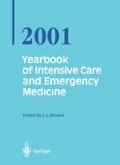Abstract
The innate immune system includes macrophages and natural killer (NK) cells, which may act directly on the pathogen or, by releasing cytokines and expressing other stimulatory molecules, trigger adaptative immune response by activating T and B cells. The strategy of the innate immune response may not be to recognize every single antigen, but rather to focus on few, highly conserved structures which are referred to as pathogen-associated molecular patterns (PAMPs). The receptors of the innate immune system that have evolved to recognize the PAMPs are called pattern-recognition receptors (Table 1). These activate signal-transduction pathways that induce the expression of a variety of immune-response genes, including inflammatory cytokines [1]. The recently identified receptors of the Toll family appear to have a major role in the induction of immune and inflammatory responses. Two discoveries support this role: the implication of the Toll-like receptors (TLRs) in innate immunity in Drosophila [2], and the identification of a TLR homolog as the gene responsible for lipopolysaccharide (LPS) responses in two natural mouse mutants [3,4].
Access this chapter
Tax calculation will be finalised at checkout
Purchases are for personal use only
Preview
Unable to display preview. Download preview PDF.
References
Janeway CA Jr, Medzhitov R (1998) Introduction: the role of innate immunity in the adaptative immune response. Semin Immunol 10:349–350
Lemaitre B, Nicolas E, Michaut L, et al (1996) The dorsoventral regulatory gene cassette spaet-zle/Toll/cactus controls the potent antifungal response in Drosophila adults. Cell 86:973–983
Poltorak A, He X, Smirnova I, et al (1998) Defective LPS signaling in C3H/HeJ and C57BL/10ScCr mice: mutations in Tir 4 gene. Science 282:2085–2088
Qureshi ST, Larivière L, Leveque G, et al (1999) Endotoxin-tolerant mice have mutations in Tlr4. J Exp Med 189:615–625
Rock FL, Hardiman G, Timans JC, et al (1998) A family of human receptors structurally related to Drosophila Toll. Proc Natl Acad Sci USA 95:588–593
Medzhitov R, Preston-Hulburt P, Janeway GA Jr (1997) A human homologue of the Drosophila Toll protein signals activation of adaptative immunity. Nature 395:384–388
Chaudhary PM, Fergusson C, Nguyen V, et al (1998) Cloning and characterization of two Toll/interleukin-1 receptor-like genes TIL3 and TIL4: evidence for a multi-gene receptor family inhumans. Blood 91:4020–4033
Takeuchi O, Kawai T, Sanjo H, et al (1999) A novel member of an expending toll-like receptor family. Gene 231–259
Hoshino K, Takeuchi O, Kawai T, et al (1999) Cutting edge: Toll-like receptor 4 (TLR4)-deficient mice are hyporesponsive to lipopolysaccharide: evidence of the Tlr4 as the Lps gene product. J Immunol 162:3749–3752
Takeuchi O, Hoshino K, Kawai T, et al (1999) Differential roles of TLR2 and TLR4 in recognition of gram-negative and gram-positive bacterial cell wall components. Immunity 11:443–451
Underbill DM, Ozinsky A, Hajjar AM, et al (1999) The Toll-like receptor 2 is recruited to macrophage phagosomes and discriminates between pathogens. Nature 401:811–815
Arbour NC, Lorenz E, Schutte BC, et al (2000) TLR4 mutations are associated with endotoxin hyporesponsiveness in humans. Nat Genet 25:187–191
Shimazu R, Akashi S, Ogata H, et al (1999) MD-2, a molecule that confers lipopolysaccharide responsiveness on Toll-like receptor 4. J Exp Med 189:1777–1782
Akashi S, Ogata H, Kirikae F, et al (2000) Regulatory roles for CD 14 and phosphatidylinositol in the signalling via Toll-like receptor 4-MD-2. Biochem Biophys Res Comm 268:172–177
Staege H, Schaffner A, Schneemann M (2000) Human Toll-like receptor 2 and 4 are targets for deactivation of mononuclear phagocytes by IL-4. Immunol Lett 71:1–3
Volk HD, Reinke P, Krausch D, et al (1996) Monocyte deactivation-rationale for a new therapeutic strategy in sepsis. Intensive Care Med 22: S474–S481
Lorenz E, Mira JP, Cornish KL, et al (2000) A novel polymorphism in the Toll-like receptor 2 gene and its potential association with staphylococcal infection. Infect Immun 68:6398–6401
Kelly RA, Smith TW (1997) Cytokines and cardiac contractile functions. Circulation 95:778–781
Bristow MR (1998) Tumor necrosis factor-alpha and cardiomyopathy. Circulation 97:1340–1341
Frantz S, Kobzik L, Kim YD, et al (1999) Toll4 (TLR4) expression in cardiac myocytes in normal and failing myocardium. J Clin Invest 104:271–280
Editor information
Editors and Affiliations
Rights and permissions
Copyright information
© 2001 Springer-Verlag Berlin Heidelberg
About this paper
Cite this paper
Gibot, S., Mira, J.P., Mebazaa, A. (2001). Toll-like Receptors: Implication in Human Disease. In: Vincent, JL. (eds) Yearbook of Intensive Care and Emergency Medicine 2001. Yearbook of Intensive Care and Emergency Medicine 2001, vol 2001. Springer, Berlin, Heidelberg. https://doi.org/10.1007/978-3-642-59467-0_7
Download citation
DOI: https://doi.org/10.1007/978-3-642-59467-0_7
Publisher Name: Springer, Berlin, Heidelberg
Print ISBN: 978-3-540-41407-0
Online ISBN: 978-3-642-59467-0
eBook Packages: Springer Book Archive

